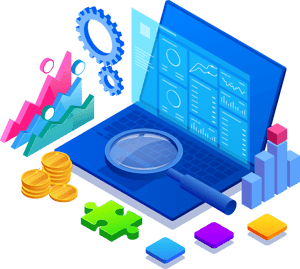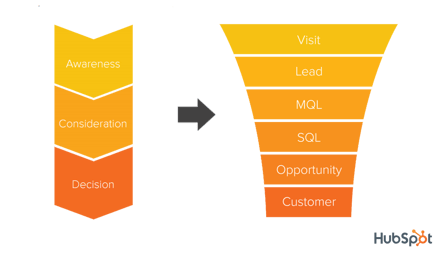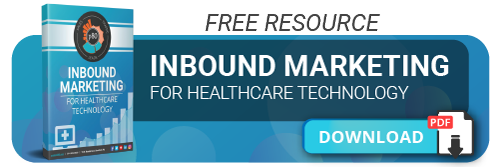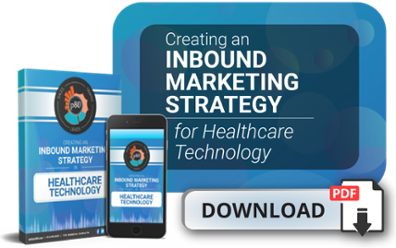CREATING AN INBOUND STRATEGY
in Health Care Technology
But what if your company could have a steady and predictable pipeline of prospects?
For healthcare technology, an inbound marketing strategy is a natural fit.
Your customers are looking for sophisticated and functional equipment or software. Your marketing strategy should be one that attracts high quality prospects and guides to the dotted line, consistently.
Let’s take a deep dive into what an inbound marketing strategy can do for you.
Contents
Engaging Today’s Buyer Through Inbound Marketing
Twenty-five years ago, marketing campaigns engaged prospects through traditional means -- newspaper ads, radio spots, and TV commercials. Potential customers looked to sales and marketing teams for more information or guidance on a product or service.
That’s not the case anymore. Buyer behavior has changed dramatically.
Now, prospects come to the buying table much more equipped to make an educated buying decision. They’re conducting research online and not interacting with a sales team until they’re ready to make a purchase. By then, they don’t need much help as their minds are already made up.
Inbound marketing bridges this gap by meeting prospects at each stage of their buyer’s journey with helpful, timely, and strategically placed content.
How Does an Inbound Marketing Strategy Work?
At its core, an inbound marketing strategy guides prospects to you through content tailored to their buying process and needs.
One of the biggest benefits of an inbound marketing strategy is that it helps boost your company’s brand awareness -- something many businesses struggle with.
Instead of injecting your company and its messaging into a prospect’s life (cold calls, LinkedIn messages, etc…), they find you through your content that helps them solve a problem or seize an opportunity.
The goal of inbound marketing is to attract, engage, and delight customers so they view their relationship with your business as a connection to a trusted resource, rather than another company just trying to peddle something.
An inbound marketing strategy can have big impacts on your company’s bottom line, creating a steady pipeline of prospects and nurturing lasting relationships with existing customers.
What Makes Up an Inbound Marketing Strategy?
An inbound strategy employs several different digital marketing tactics you’ve heard about and makes them all work together to draw in prospects and nurture leads.

Content
Content, such as blogs, videos, or ebooks, are at the heart of an inbound marketing strategy. Having an effective content strategy is how you establish your brand as a thought leader in your industry, as well as provide the answers your prospects are looking for online.

Social Media
A high-quality social content strategy is a necessity when it comes to inbound marketing. It’s a quick way to reach new prospects, stay in the radar of existing leads & past customers, and further establish your company as an authority.

Long gone are the days where cold-calls were the strategy for selling a product or service. It’s not lost on us (or anyone else) that people don’t tend to answer a phone call from a number they don’t know. Email can be a more effective way to reach prospects. Lead nurturing (More on that later) is a great way to continue to build trust and guide prospects through their buying process.
![]()
SEO
Search engine optimization, or SEO, is one of the most critical aspects of inbound marketing. It is the practice of optimizing your website for keywords in compliance with Google’s best practices. In other words, SEO helps your website appear higher in search engine results pages (SERPs). Factors such as site speed, poorly written content, and other behind the scenes elements of a website can impact its performance in bringing your company new prospects who will become leads. If SEO issues hamper your website’s Google ranking, prospects won’t be able to find it and consume its content.
![]() Buyer Personas: The Foundation of an Inbound Marketing Strategy
Buyer Personas: The Foundation of an Inbound Marketing Strategy
For healthcare technology marketers, having a complete understanding of the ideal prospect is essential to developing a solid inbound marketing strategy.
That’s where buyer personas come in.
A buyer persona is a semi-fictitious profile of your ideal customer. It’s based on market research, real data about existing customers, and a smattering of educated guesses.
Buyer personas are not target markets, which represent a particular market segment that a strategy focuses on. Buyer personas are much more specific.
Why Bother With Buyer Personas in Healthcare Tech Marketing?
A buyer persona is the foundation of a marketing strategy. Every part of a marketing effort -- from conducting further research to developing tactics -- centers around engaging your ideal customer and nurturing them from a prospect to a satisfied customer.
What Goes Into a Buyer Persona?
Ask yourself: How well do you know the prospect you’re hoping to make your next satisfied customer? What does their job really entail? What are the daily struggles they face in their industry? Or what about the resources they turn to?
Buyer personas take a deep dive into those questions, plus much more. They touch on key information, such as:
- Demographics
- Motivations
- Goals
- Behaviors
- Pain points
Creating a Buyer Persona
Just like your ideal prospect, a buyer persona is complex. It should be very detailed. Don’t expect to complete it in a day.
The cornerstone of a solid buyer persona is research -- both primary and secondary. Without the proper research, determining who your ideal customer is will be based strictly on conjecture and speculation.
Conducting buyer interviews are one of the most effective ways to source primary research -- they give you first-hand knowledge from real people, such as your existing customers and prospects you’re already working with. Surveys are also helpful in getting insights -- even if they’re critical -- as some respondents may prefer to forego a face-to-face interview.
Don’t forget to talk to members of your sales and customer service teams -- they deal with prospects every day. They can tell you what’s worked in converting prospects into customers, as well as what doesn’t.
Meeting your ideal prospect
Once you’ve completed your research, you can start to form the profile of your ideal prospect. Your persona should give detailed answers to the 5 W’s about your ideal customer and their buyer’s journey:
- Who
- What
- Where
- When
- Why
Every prospect your company deals with is somewhere on their buyer’s journey, whether they’re just scouring the internet for information or are ready to make a purchasing decision to solve a problem.
With a buyer persona clearly defining your ideal prospect, what they’re up against, and how they operate, you can start formulating content to meet their needs at every stage of their buyer’s journey.
Remember: Prospects evolve. Your company’s priorities can change. Your buyer persona should, too. In other words, it’s a good habit to regularly revisit your buyer persona
Need help getting started with your buyer persona? Check out our Ultimate Buyer Persona Guide.
 Giving Your Healthcare Technology Company a Brand Voice
Giving Your Healthcare Technology Company a Brand Voice
With a buyer persona in hand, it might seem natural to start content production and begin engaging prospects.
Hold on.
Before diving into content creation, take a step back and consider your brand’s voice. Your buyer persona will play a big role in what that voice sounds like and how you want to “speak” to prospects.
Your company’s brand voice represents its personality. Brand voice is conveyed through words, tone of voice, and even images -- think Nike’s swoosh and “Just do it” campaign.
Brand voice shouldn’t be confused with brand identity, though there is some overlap. Brand voice is how you articulate your brand identity.
Spending time to refine or create your brand’s voice ensures your company is delivering consistent messages and there are no surprises as prospects become familiar with it.
Developing Your Healthcare Tech Company’s Brand Voice
As mentioned earlier, remember your buyer persona when you start to create your brand voice Your brand voice should resonate with your ideal prospect, not drive them away or convey the wrong tone.
Other steps to take when creating your brand voice include:
- Defining company values
- Auditing existing content for tone
- Examining your competition’s brand voice and avoiding sounding like them
And just like the buyer persona you developed, creating a brand voice for your company takes time And it takes input from company stakeholders. And it’s ever evolving just like your prospects.
For healthcare tech marketers, creating an appropriate and engaging brand voice guides prospects to have the right perception of your company as they interact with your content.

Leveraging Content in an Inbound Marketing Strategy
As it’s been said many times: Content is king.
In the world of inbound marketing and sales, this is true now more than ever.
As we touched on earlier, prospects are well informed when they reach the point of purchase. Content you produce can play a key role in a prospect’s education.
Inbound marketing content takes many forms:
- Blogs
- Social media posts
- Videos
- Ebooks
- White Papers
- Podcasts
Your content should always be purposeful and helpful. Prospects engaging with it should feel they walked away better equipped to solve their problem. Your content should provide real information they can immediately put to use.
Boosting Content Through SEO

Producing SEO-optimized content that satisfies your potential customers’ needs will not only increase your authority on the topics you cover, but will also provide multiple opportunities to rank for relevant keywords that will ultimately mimic the queries prospects are searching.
For instance, an EMT that’s exploring electronic medical record (EMR) software options is conducting Google searches that go beyond just searching the term “electronic medical records software.”
Chances are they’re conducting question-based searches or queries with multiple search terms related to EMR:
- What is the best EMR software?
- HIPAA compliant EMR software
- Mobile-friendly EMR
Aligning Content With the Buyer’s Journey
Through inbound marketing, your content can be part of a prospect’s buyer’s journey at any stage, providing them with the information they need when they need it. The right content keeps prospects engaged, returning for more, and builds trust.
The Buyer’s Journey Down the Marketing Funnel

The inbound marketing follows the 3 stages of the buyer’s journey: awareness, consideration, and decision. Each stage represents a different position in a healthcare technology prospect’s buying process. Inbound marketers use this information to cater their content to their buyer's needs at each stage.
The buyer’s journey easily syncs with the marketing funnel, which ultimately converts a website visitor to a satisfied customer.
Awareness Stage
Healthcare tech prospects in the awareness stage are identifying their problem or opportunity. They’ll be searching for more general questions about their pain point(s). Having content that answers these general questions will start to pull them in to the top of the inbound funnel.
Create a series of educational blogs or videos, or even an ebook, showing prospects potential solutions to their most commonly researched problems.
Going back to our example of the EMT interested in electronic medical record keeping software, they may find value in blogs or videos on topics such as:
- 5 Benefits of Electronic Medical Record Software
- Functions Electronic Medical Record Software Should Include
- Maintaining HIPAA Compliance With Electronic Medical Record Software
Consideration Stage
Prospects have defined their problem or opportunity at this stage of their buyer’s journey. They’re now doing the research to determine possible solutions. They’re comparing ways to solve their problem or leverage their opportunity.
At this point, your content should start nurturing your leads by maintaining contact with them after their first touch point and continuing to provide them with relevant resources that guide them further down the inbound funnel.
This could be as simple as offering them:
- Ebook guides
- Whitepapers
- One-on-one consultations
- Webinars
Perhaps that EMT exploring electronic medical records software has some questions and could benefit from an actual conversation with a member of your sales team.
Decision Stage
Buyers at this point in the inbound funnel know the solution they need. They’re just searching for a business that can provide it. Who better than your company?
The decision stage is about setting yourself apart from your competitors. Do you have a case study that shows how your EMR software leads to 10X productivity? Do you have a testimonial from a healthcare behemoth? Or can you get your product in their hands with a demo or free trial?
Product demos can be the deciding factor for prospects when they are at the bottom of the marketing funnel and nearing the end of their buyer’s journey. Not only do demos provide you with another opportunity to engage with a prospect, but they also allow prospects to see exactly how your product mitigates their pain point(s).

 Harnessing Social Media in an Inbound Marketing Strategy
Harnessing Social Media in an Inbound Marketing Strategy
Social media is a source for quick wins in an inbound marketing strategy.
Providing your followers with relevant, original (as well as third-party) content on a consistent basis is the key to accumulating a consistent stream of website traffic and engagement. It keeps your company on the radar.
Eventually, once your followers see that you are producing blogs, graphics, or video content that provides a solution to one of their pain points, they will start coming back to consume more content that answers more of their questions.
The Right Posts on the Right Platform
In the social media sphere, it’s important to remember there are nuances in how the most popular 3 platforms -- Facebook, Twitter, and LinkedIn -- are used by professionals.
What works on Twitter may not work as well on LinkedIn.
Each platform serves different purposes for different audiences. Make sure your messaging is appropriate and done well for the platform your posting on -- poor judgement or a post full of errors only casts doubt about your company and erodes its credibility.
Twitter is more of a catch-all for short, punchy conversations and is often used for customer service types of engagements, while Facebook serves an older audience who is more apt to have a longer digital conversation. LinkedIn is where professionals go online to network or find resources.
Maximizing Post Reach to New Prospects
One of the easiest ways to engage prospects on social media at all stages of their buyer’s journey is through integrating hashtags into posts.
A hashtag is a word or series of words (with no spaces) preceded by a pound sign (#), more formally known as an “octothorp.” It’s purpose? To connect posts about a certain topic. Hashtagged items can appear anywhere in a post.
Hashtags allow a social network to categorize and group posts together in a single stream, making it easier for those searching for a specific topic to find related information.
Becoming Part of a Buyer’s Journey Through Hashtags
A hashtagged post gets your information in front of a prospect as they seek resources. It also makes sure your company is part of a conversation about a specific topic you’re targeting.
In the awareness stage, a prospect has found they have an issue that needs to be addressed and are just starting to define exactly what their issue is and are doing some cursory research. While in the consideration stage, a potential buyer knows exactly what their issue is and is in research mode, seeking out more information to help them solve the problem.
During both these stages, healthcare tech marketers can use hashtags in social posts to draw in prospects who otherwise may not have found them through traditional online searches.
In the decision stage, leads can use your company’s hashtag or branded hashtag to see what others are saying about you and their experiences with your product. Think of it as a mini reference check.
 Converting Leads to Customers Through Email & Automation
Converting Leads to Customers Through Email & Automation
Inbound marketing is about connecting with a prospect on a 1-to-1 level. It’s about building a rapport with a prospect and earning their trust.
With the steady pipeline of prospects an inbound marketing strategy can create for your healthcare tech company, keeping up may seem like a big challenge.
An email marketing plan through an inbound strategy -- complete with automated workflows -- can take some of that pressure away and provide content at an appropriate cadence.
Particularly during the consideration and decision stages of the buyer’s journey, email can quite literally deliver continuous, personalized prospect engagement. Marketing automation software makes it even easier.
Email as a Guide for the Buyer’s Journey
An email marketing effort coupled with marketing automation also helps your inbound marketing strategy be more effective in real time.
Through customer relationship management (CRM) tools, specific emails can be sent to specific people -- from prospects at the very beginning of their buyers journey to past customers you’re hoping to see repeat business from. You can even filter out cold leads, allowing you to focus your resources on promising prospects.
Think back to our EMT looking for more information on electronic medical records software. Suppose you have software that could help them and they’ve taken the first step by providing you with his email address in exchange for a resource.
Through email lead nurturing, you’ve got a golden opportunity to help them take the next step in engaging your company. Through an automated email workflow, your company could send them an email after a few days offering more resources:
Hello [contact name]
I noticed you [acknowledge the action they took]. Here are a few additional resources that I thought you might also find useful
- Resource 1
- Resource 2
Please let me know if I can help you get started.
Sincerely,
[Your name & contact info]
After the EMT takes you up on your offer for help and has a conversation with you, your company can become a bigger part of their buyer’s journey with more purposeful emails specific to their pain points.
A follow-up email could look like:
Hello [contact name]
It was great talking with you on [date or day of conversation]. I really enjoyed our conversation about [acknowledge what you discussed]
I wanted to pass along a few of our resources that I thought you might find helpful and could answer any additional questions that may have come up.
[Your name]
With a firm grasp of a prospect’s pain points and needs, you can send another appropriately timed email introducing exactly how your company can solve their problem(s):
Hello [contact name]
I can tell that solving [acknowledge pain point(s)] you mentioned are very important to you. I wanted to talk more with you about how [your company’s name] can help you with this. We’ve helped companies similar to yours with the same issues.
[Mention a product/service your company has that can address the pain points(s) you discussed. Is there a free trial you can offer? Can you set up a product demo?]
Do you have any time within the next week for a call?
[Your name]
While these email examples each serve a different purpose individually, they’re part of a much bigger goal: building rapport and trust with a prospect, while ushering them along their buyer’s journey to become a happy -- and hopefully, repeat -- customer.
Measuring Success of an Inbound Marketing Strategy
Like any successful marketing effort, an inbound marketing strategy requires consistent monitoring.
But with so many moving parts, it’s important to make sure the effort you put into developing an inbound strategy is paying off. The only way to truly gauge this is through measurement.
Metrics are one of the most important parts of any inbound marketing strategy -- they tell you what’s working or underperforming. They provide you with an opportunity to evaluate the success of your marketing efforts in real time and fine tune a strategy on the fly.
Zeroing in on the Most Meaningful Metrics
In looking at a performance report of your inbound marketing campaign’s performance, it might seem … overwhelming.
Some of the most important metrics to measure success of an inbound marketing strategy include:
Overall Website Traffic: The total number of visits a website gets during a set period of time.
New Visitor/Returning Visitor Rate: The ratio of someone who has never visited a website before vs. the number of visitors who have come back. It’s calculated by dividing the number of return visitors by the total number of unique visits to a website.
Traffic Source: Where website visitors are coming from. There are 4 main visitor categories:
- Organic -- Those who found your website through a search engine.
- Direct -- Those who typed your URL into a web browser’s address bar.
- Referral -- Those who came to your website through a backlink (link posted on another website).
- Social Media -- Those who found a link to your website on a social network
- Email -- Those who came to your website through a link in an email (sometimes categorized as direct)
Time Spent on Website: This metric is as it sounds -- the amount of time a visitor spends on a website.
Click-through Rates: The number of clicks a link receives. It’s calculated by dividing the total number of clicks on a link by the total number of impressions (instances when someone saw the link).
Exit Rate: The percentage of visitors who leave a website altogether from a specific webpage. The exit rate does account for a visitor spending time on multiple pages of a website. It’s calculated by dividing the total number of exits from a webpage by the total number of visits to the page.
Bounce Rate: This is somewhat of an extension of the previous metric. Bounce rate represents the percentage of visitors who navigate away from a website after only viewing 1 webpage for a very short amount of time. Think of a bounce as when you Google something and click on a result, but quickly hit your back button because the site wasn’t what you wanted. It’s calculated by dividing the total number of visitors viewing only 1 page by the total number of visits to a specific page.
Social Media Audience: The number of followers a company or brand has across social media platforms.
Social Media Engagement: Users and followers interacting with social media posts, e.g. likes, shares, or comments.
Conversion Rates: The number of website visitors who completed a desired action (sign up for a demo, download an ebook, etc.) and became leads.
Using Metrics for Campaign Success
These metrics provide you with a great glimpse into the effectiveness of your inbound marketing strategy. They can -- and should -- be checked often, though there is no one-size-fits-all standard.
Social media can be monitored in real-time, and because of the level of interaction it invites you should check your posts often. On the other hand, overall website metrics are something that’s best tracked on a month-by-month basis. Daily website traffic will, at best, give you a snapshot of an inbound marketing campaign’s impact.
The time to check the various metrics of your inbound marketing campaign is not at its conclusion. By then, it’s too late to take any proactive steps to improving the campaign’s performance.
Regularly checking the performance of each part of your campaign ensures that you can make adjustments in a timely manner and prove to your stakeholders the impacts your inbound marketing strategy is having on business.
Inbound Marketing for Lasting Success
As we’ve seen many times over, a well developed inbound marketing strategy provides meaningful impacts to a company’s bottom line, bringing a steady flow of potential customers to you.
Through an inbound marketing strategy, your company and its suite of resources become part of a buyer’s journey without coming across as pushy or self-serving. Your inbound strategy becomes an organic fit for prospects and optimizes sales opportunities with the right clients.
Still have questions about Creating an Inbound Marketing Strategy in Healthcare Technology? Or do you want to take a second pass at all this information? Download a PDF of everything here to digest at your own leisure!
Inbound Marketing Drives Leads...
...but it requires a solid strategy, and often time.
Want to kickstart your inbound program? Use the form to the right to speak with one of our experts!




